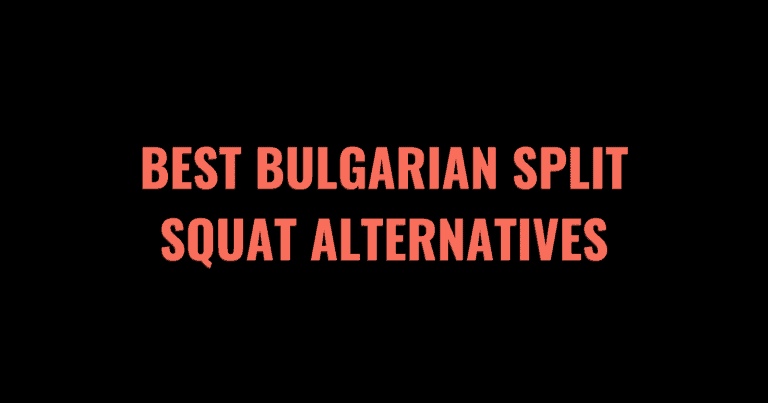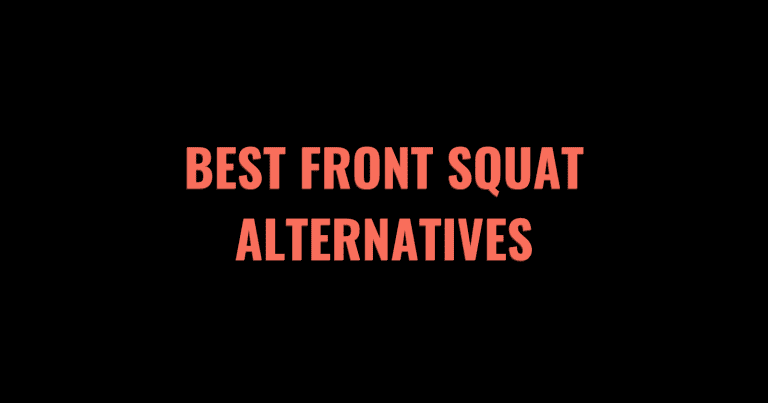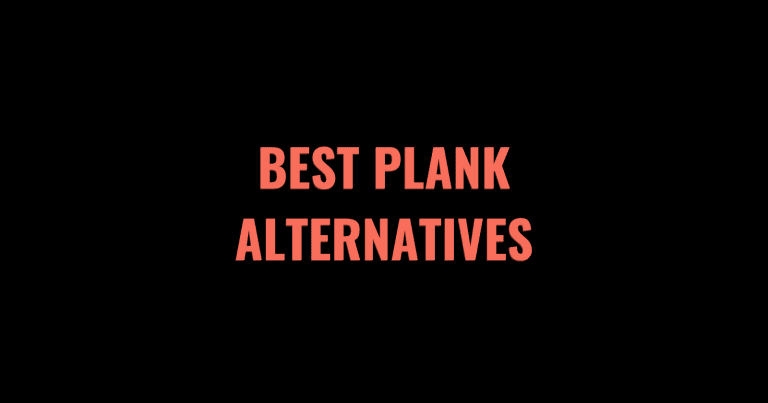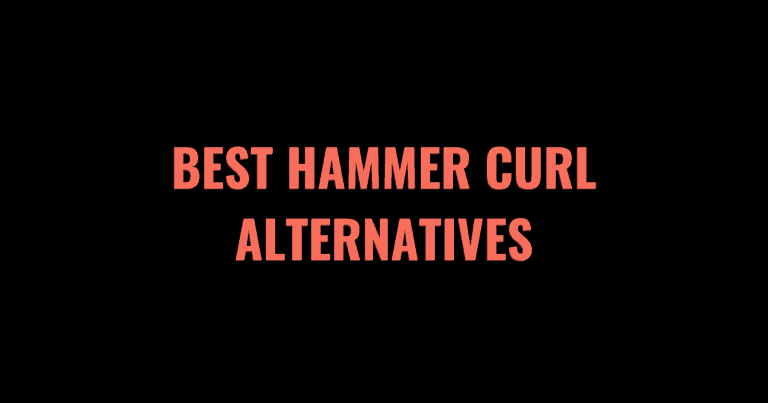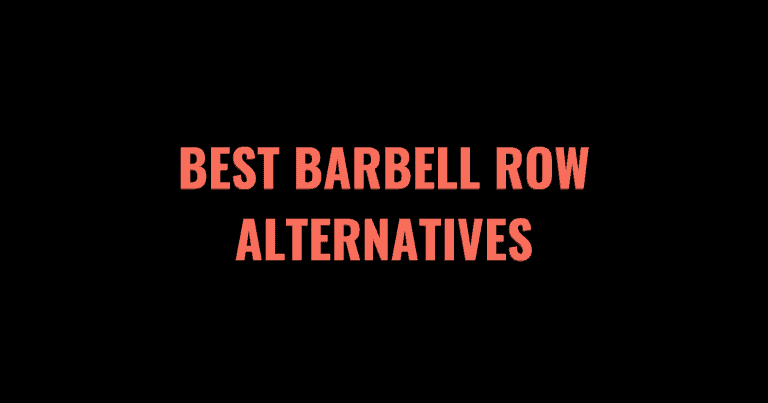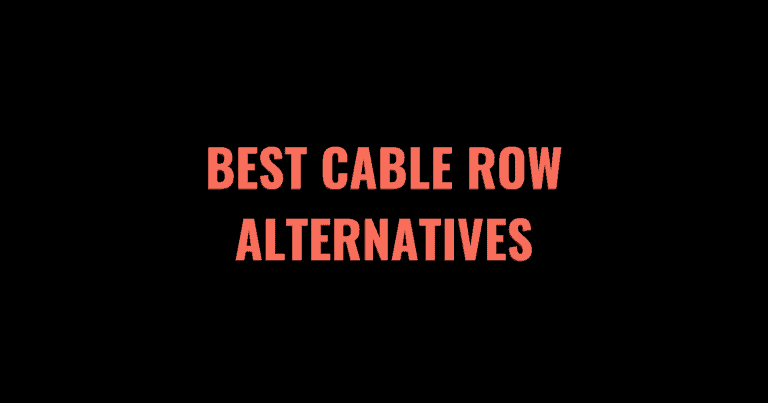The leg press is a machine-based exercise that’s very effective at building the quads, glutes, and hamstrings. Although the leg press is a great exercise, a common question in the fitness industry is, “what can I use instead of a leg press?”
Perhaps your gym doesn’t have a leg press, you work out at home, or are often on the road. What if you want to further isolate the quads because they are a lagging body part? Or maybe you’re an athlete looking for something more functional.
There are a number of reasons that may leave you looking for a leg press alternative, such as equipment limitations, physical limitations, the need for exercise variation, and further isolation of a specific muscle group.
The good news is that there are several exercises that you can do to target the quads, glutes, and hamstrings, no matter what your situation is! And that’s exactly what we are going to cover in this article!
Without further ado, here’s our definitive list of the best leg press alternatives!
Table of Contents
- 1 The 9 Best Leg Press Alternatives
- 2 Reasons to choose a leg press alternative
- 3 Muscles worked by the leg press
- 4 Frequently Asked Questions
- 5 Closing Remarks
- 6 Other Alternative Exercises
- 6.1 The 10 Best Romanian Deadlift Alternatives
- 6.2 The 10 Best Dumbbell Pullover Alternatives
- 6.3 The 10 Best Bulgarian Split Squat Alternatives
- 6.4 The 10 Best Front Squat Alternatives
- 6.5 The 10 Best Hack Squat Alternatives
- 6.6 The 10 Best Plank Alternatives
- 6.7 The 8 Best Hammer Curl Alternatives
- 6.8 The 10 Best Overhead Press Alternatives
- 6.9 The 10 Best Lat Pulldown Alternatives
- 6.10 The 10 Best Pallof Press Alternatives
- 6.11 The 9 Best Barbell Row Alternatives
- 6.12 The 8 Best Decline Bench Press Alternatives
- 6.13 The 9 Best Pendlay Row Alternatives
- 6.14 The 9 Best Seated Cable Row Alternatives (2023)
- 6.15 The 10 Best Bent Over Row Alternatives
The 9 Best Leg Press Alternatives
- Back Squats
- Front Squats
- Hack Squats
- Leg Extensions
- V-Squats
- Goblet Squats
- Bulgarian Split Squats
- Inverted Smith Machine Leg Press
- Lunges
Back Squats
When to perform back squats
Back squats versus leg press. This comparison is one of the most commonly debated topics in the fitness industry. Many make the argument that if you can properly perform a back squat without pain, that’s the better option for several reasons.
The back squat is more functional, it recruits a greater amount of muscle groups, and you aren’t limited by the path of motion of a machine. Not to mention, you can do a squat anywhere, even if it’s just bodyweight squats.
In addition to the quads, back squats target the glutes, core, hamstring, calves, erectors, and upper back. The back squat is a superior alternative if you’re looking to compete in powerlifting, strongman, CrossFit, or Olympic lifting.
Since back squats primarily target the legs, they are usually programmed on leg days or lower body workouts. For those that train full-body, squats are a staple because so many muscles are working at once.
How to perform back squats
- To do this exercise, you will need an Olympic barbell, squat rack, safety clips, and plates. Flat-soled shoes or Olympic weightlifting shoes work best for this exercise.
- Set up the squat rack to just below shoulder height and adjust the safety bars to an appropriate height according to your squat depth.
- Step under the bar and place it on your upper traps. Grab the bar with your hands on each side. There should be a slight bend in your knees at this point.
- Stand up straight to unrack the barbell and take 2-3 steps backward.
- Assume a slightly wider than shoulder-width stance with your toes pointed out at a 45-60 degree angle. Your feet should remain planted on the ground at all times.
- Before starting the movement, take a deep breath and brace your core.
- Begin the descent by bending at the hips and knees at the same time. Picture yourself sitting down on a chair.
- Continue to descend until your knees create a 90-degree angle or when your hips pass just below parallel.
- At the bottom of the rep, pause for 1-2 seconds, then explode up by driving through your heels and midfoot. Halfway up, extend your hips forward to complete the rep. On the way up, focus on keeping your knees out, do not let them collapse inward.
- Repeat for the desired number of repetitions.
Check out this video from Jeff Nippard to see how to improve your squat form and lift more weight!
Back squat tips
- Using a belt may be helpful if you’re lifting in a low rep range and are trying to maximize your strength.
- If you struggle with reaching proper depth, try squatting with plates under your heels or Olympic lifting shoes.
- Film yourself to critique your form to see how you can improve.
- Adjust your stance to target the quads or glutes/hamstrings more or less. A narrow stance will emphasize the quads more, whereas a wider stance will better engage the glutes/hamstrings.
- Experiment with low bar and high bar positions to see what feels more comfortable to you.
Front Squats
When to perform front squats
One of the benefits of the leg press is that you can adjust your stance to emphasize the quads or glutes and hamstrings. The same can be done with barbell squats by altering your stance and adjusting the bar position!
Compared to back squats, front squats target the quads to a greater extent than the glutes and hamstrings. If your main goal is to grow and strengthen your quads, a front squat may be a better option.
Not to mention, if you want to do CrossFit and/or Olympic Weightlifting, becoming proficient at the front squat will have a better carry-over to other movements, such as the clean and jerk.
Since front squats are a compound leg movement and recruit multiple muscle groups, performing them at the beginning of a lower-body workout is a good idea.
How to perform front squats
- To do this exercise, you will need a squat rack, Olympic barbell, plates, and safety clips.
- Set up the squat rack to just below shoulder height. There should be just a slight bend in your knees when you un-rack and re-rack the barbell. Adjust the safety bars to an appropriate height based on your squat depth.
- Step up to the barbell, raise your arms out in front of you, and place the barbell on the top of your front delts. The barbell should be close to your neck but resting against it.
- Bend elbows backward and hook 2-3 fingers under the barbell. Your fingers will help keep the bar steady.
- Brace your core, lift your chest and elbows up, and stand straight up to un-rack the barbell.
- Take 2-3 steps back and assume a shoulder-width stance with your toes pointed slightly out. Your weight should be evenly distributed between your big toe, mid-foot, and heels.
- Inhale, brace your core, and begin to squat by bending at the hips and knees simultaneously. Imagine that you’re sitting on a chair.
- Once your knees make a 90-degree angle, or your butt reaches below parallel, pause for 1-2 seconds.
- Exhale as you explode up by extending your knees and hips to stand up.
- As you reach lockout, push your hips forward to complete the rep.
- Repeat for the desired number of repetitions.
In the video below, Jeff Nippard demonstrates how to correctly execute the barbell front squat!
Front squat tips
- Focus on keeping your chest and elbows up, especially at the bottom of the rep, to prevent the bar from sliding forward.
- If you lack the shoulder and wrist mobility to hold the bar with a proper front rack position, try out other ways to hold the bar, such as with lifting straps or the arms-crossed position.
- To target the quads more, put plates under your heels or use Olympic weightlifting shoes that have a raised heel.
- Front squats are crucial if you’re planning on doing Olympic weightlifting or CrossFit.
- Don’t let your knees cave in or collapse on the upward portion of the lift, especially when you’re coming out of the position.
Hack Squats
When to perform hack squats
In terms of machine exercises, the hack squat is arguably the best alternative to the leg press. Similar to the leg press, the hack squat works the lower body without taxing other muscles such as the core or lower back.
It places less stress on the spine and doesn’t require nearly as much balance or coordination as a free-weight squat or lunge. Because of those reasons, it’s also safer to train for failure, especially since you don’t need a spotter due to the built-in safety bars.
Compared to the leg press, the hack squat mimics a squatting motion to a greater extent, giving it a better carry over to the back squat. Furthermore, if you want to target your quads more, the hack squat is likely a better option than the leg press.
If you have been doing leg press for a while and have hit a plateau, switching to a hack squat might be just what you need to spark new muscle tissue growth.
Hack squats should be programmed on leg days near the beginning of a workout because they are a compound movement that requires a good amount of energy.
How to perform hack squats
- Set up the machine to an appropriate height. You should be able to easily un-rack and re-rack the sled without having to stand on your tip-toes. On some machines, you can adjust the angle of the platform, so if that’s an option, move it to a position that feels most comfortable. After the set-up is complete, add an appropriate amount of weight.
- Step onto the platform, and assume a shoulder-width stance with your toes pointed forward or slightly out.
- Place your head, back, and shoulders against the appropriate support pads.
- Unrack the sled by extending your legs and moving the safety bars out of the way.
- Grab the handles on the shoulder pads, take a deep breath, brace your core, and begin by bending your knees and hips to lower the sled.
- Once your knees form a 90-degree angle, or your hips reach just below parallel, pause for 1-2 seconds.
- Exhale as you explode up by extending your knees and hips to push the sled back to the starting position.
- At the top of the rep, stop just before lockout to keep tension on your quads.
- Repeat for the desired number of repetitions.
Watch the video below from Renaissance Periodization to see how to perform the hack squat properly and 9 common mistakes to look out for!
Hack squat tips
- Keep your heels on the platform throughout the entire movement.
- Don’t lock out your legs at the top of the rep to keep tension on the quads.
- Use a closer stance to emphasize the quads more.
- Avoid letting your knees collapse on the concentric (upward) portion of the lift.
- Flat-soled shoes are ideal for this exercise.
Leg Extensions
When to perform leg extensions
Leg extensions are one of the only exercises that completely isolates the quads. If your quads are a lagging muscle group, and you want to focus on improving them, leg extensions are a good idea because they don’t tax any other muscle group.
Another reason why you may consider doing leg extensions as opposed to the leg press is that the leg extension is the only exercise that works the rectus femoris. The rectus femoris is one of the quad muscles, and it’s the only muscle that crosses the knee and hip. When you’re performing an exercise that involves hip and knee flexion (squats, leg press, etc.), the rectus femoris is not getting worked to its full extent.
For this reason, some people make the argument that leg extensions are crucial to optimize leg development. If you’re already doing squats and lunges, adding in leg extensions as opposed to leg press may be beneficial.
More often than not, leg extensions are performed near the end of a leg workout, but you can also do them at the beginning as a warm-up or pre-exhaust exercise.
How to perform leg extensions
- Adjust the machine to the appropriate settings based on your height and desired range of motion. The leg pad should be positioned just above the front of your ankles with your knees at a 90-degree angle. After the set-up is complete, select an appropriate amount of weight.
- Sit down on the machine, place your head and back against the support pad, and hook your feet under the leg pad.
- Grab the handles on both sides of the machine and pull down so that your butt stays secure on the seat.
- Take a deep breath and exhale as you extend your legs to move the pad away from you. Keep going until they are almost fully extended and you feel a strong contraction in your quads.
- At the top of the rep, hold the contraction for 1-2 seconds.
- Slowly lower the pad back to the starting position by bending your knees.
- Repeat for the desired number of repetitions.
If you want to learn how to perform leg extensions with perfect technique, watch the video below!
Leg extension tips
- If one leg is stronger than the other, we highly recommend doing single-leg leg extensions. Start with your weaker side and match the number of repetitions you get with the stronger side.
- Adjust the angle of your leg to hit more of the inner quad or outer quad (i.e., toes pointed in, toes pointed out, or toes pointed straight ahead).
- Unlike compound movements, leg extensions can be performed at the beginning of the workout as a pre-exhaust/warm-up or at the end as a finisher.
V-Squats
When to perform v-squats
V-squats are another machine-based exercise that serves as an alternative to a leg press. Since the weight is loaded on your shoulders, more muscles are engaged, including the core and lower back, to stabilize the spine. V-squats closely resemble free weight squats, so they may have better carry over to the back squat or front squat than a leg press.
Since V-squats have a set path of motion and safety mechanisms, you can safely train to failure without a spotter. By adjusting your stance and position, you can emphasize the quads or glutes and hamstrings more or less. Facing away from the machine and using a wider stance allows you to hit the glutes and hamstrings more. Conversely, a narrow stance targets the quads more.
V-squats are usually programmed on leg workouts and performed as the 1st or second exercise.
How to perform v-squats
- Set-up the machine to a height where you can safely un-rack and re-rack the machine. There should be a slight bend in your knees when the machine is in the racked position. Load an appropriate amount of weight onto each side of the machine.
- Step onto the platform, assume a shoulder-width stance with your toes slightly pointed out, place your shoulders under the support pads, and rest your head and back on the pad.
- Extend your legs to lift the machine off the safety bar, then move the safety bar out of the way by pulling on the handle.
- Take a deep breath, brace your core, and slowly bend your knees and hips simultaneously (similar to a squat).
- Once your knees reach 90 degrees or your hips are just below parallel, pause for 1-2 seconds.
- Exhale as you extend your knees and hips to lift the weight and return back to the starting position.
- At the top of the rep, don’t lock out your knees to keep constant tension on the legs.
- Repeat for the desired number of repetitions.
In the video below, 4x Mr. Olympia Jay Cutler shows you how to perform the machine v-squat!
V-squat tips
- Flat-soled shoes work best for this exercise.
- Adjust your stance to emphasize your quads or glutes-hamstrings.
- Don’t completely lock out your knees at the top of the rep.
- Load an even amount of weight on each side of the machine.
Goblet Squats
When to perform goblet squats
Whether you’re at the gym, on the road, or training at home, the goblet squat is an exercise you can perform! One of the biggest downfalls to the leg press is that it’s a machine that not everyone has access to. Fortunately, if you’re in this situation, you can still work the same muscles by performing the goblet squat.
The goblet squat is a great option for anyone that lacks the mobility to perform a front squat, doesn’t have a squat rack, and/or is looking to learn how to squat properly. All you need to do this exercise is a dumbbell or kettlebell! Holding the weight in front of you places more tension on the quads, which mimics a front squat and close-stance leg press.
Goblet squats are usually performed during leg workouts as the first, second, or third exercise. Although the goblet squat is a compound lift, they aren’t as taxing as a barbell back squat or barbell front squat because it does not load the spine.
How to perform goblet squats
- This exercise can be performed with a kettlebell or dumbbell. If you’re using a kettlebell, grab it by the “horns” (the sides of its handle). If you’re using a dumbbell, set it up vertically and grab one end of it.
- Stand up straight and pick the kettlebell or dumbbell up. Hold it against your chest.
- Assume a shoulder-width stance with your toes pointed slightly out.
- Take a deep breath and begin to squat by bending at the knees and hips. Focus on keeping your chest up to maintain an upright position. Your elbows should be inside the line of your knees.
- Once your knees form a 90-degree angle or your hips reach just below parallel, pause for 1-2 seconds.
- Exhale as you stand back up by extending your hips and knees. Focus on pushing through your heels.
- At the top of the rep, squeeze your quads, glutes, and hamstrings.
- Repeat for the desired number of repetitions.
Scott Herman demonstrates how to perform the goblet squat in the video below!
Goblet squat tips
- Flat-soled shoes work best for this exercise.
- To emphasize the quads more, place plates under your heels or use shoes with an elevated heel such as Olympic weightlifting shoes.
- Try to remain as upright as possible during the entire movement.
Bulgarian Split Squats
When to perform Bulgarian split squats
Bulgarian split squats are a phenomenal exercise for improving balance, stability, strength, and size of the lower body. More often than not, the average gym-goer will have one leg that’s stronger than the other, which is referred to as a muscular imbalance.
Whether you’re an athlete, physique competitor, or just an average joe, having one leg that’s stronger and/or bigger than the other is not advantageous. Not only does it look strange in the mirror, but it will have a negative impact on your performance and may increase your risk of injury.
One of the best ways to combat strength/muscular imbalances is by performing unilateral exercises, such as the lunge or Bulgarian split-squat. When performing this exercise, it’s important to start with the weaker leg and do the same number of repetitions with the opposite side. Over time, this approach will help balance out both sides and improve the overall symmetry of your physique.
If you’re already performing a lot of bilateral exercises, such as the back squat, front squat, and hack squat, you’d be better off doing a Bulgarian split squat rather than the leg press.
Not to mention, you don’t need any machines to do this exercise; all you really need is some dumbbells or kettlebells. If you’re a beginner, start with just your body weight!
Bulgarian split squats are a lower-body dominant movement, so they are usually performed during the beginning or middle of a leg workout.
How to perform Bulgarian split squats
- To do this exercise, you will need some dumbbells and a raised surface to place your foot on such as a flat bench or a box. This exercise can also be performed with a barbell, smith machine, kettlebells, or no weight, depending on your experience level and equipment selection.
- Grab a dumbbell in each hand using a neutral grip. Let the dumbbells hang by your sides.
- Stand facing away from a bench. Take 2-3 steps forward and place your left or right foot back onto the bench to create a split-stance (similar to a lunge). The top of your foot should be touching the bench at all times.
- Begin the exercise by taking a deep breath and bracing your core. Start the descent by bending the knee of the foot that’s placed forward.
- Continue to lower until your front leg forms a 90-degree angle or your back leg touches the ground.
- At the bottom of the rep, pause for 1-2 seconds then exhale as you explode up by straightening the front leg until you’re back to the starting position.
- Continue for the desired number of repetitions. Then switch legs and repeat.
Check out the video below from Squat University for the ultimate Bulgarian split squat tutorial!
Bulgarian split squat tips
- Always start with your weaker leg first and do the same number of repetitions with the stronger leg.
- Most of your weight should be placed on the leg that’s forward. The leg that’s back is simply there for balance and support.
- Experiment with holding two dumbbells or just one to see which method feels most comfortable.
- If you’re struggling to balance, start with the smith machine or hold onto a squat rack to get the movement down.
- The wider your split stance is the more your glutes and hamstrings will be engaged. If the quads are your focus, use a closer split stance.
Inverted Smith Machine Leg Press
When to perform the inverted smith machine leg press
If all you have access to is a smith machine and you’re programmed to do a leg press, the inverted smith machine leg press is the closest exercise alternative you can perform. Unlike a squat, hack squat, or lunge, during the inverted smith machine leg press, the upper body is doing little to no work, while the legs are doing all of the work.
If your goal is to target the legs while minimizing spinal loading and upper body engagement, this is the exercise alternative we would recommend other than the leg extension. Furthermore, this variation targets more of the hamstrings, so if that’s a lagging muscle group that you want to improve, this may be a better variation compared to a standard leg press.
It’s also important to note that some old-school gyms may have a legit vertical leg press, which is practically the same thing as an inverted smith machine leg press. If your gym has that, it’s likely better than the smith machine variation because it’s built for that.
The inverted smith machine leg press is solely a lower-body exercise, so it’s a good idea to perform them as the 2nd or 3rd exercise of a leg workout.
How to perform the inverted smith machine leg press
- Adjust the smith machine to the appropriate height. It should be at a level where you can safely unrack the bar with a slight bend in your knees as you lay on the floor. If your smith machine has safety bars, raise them to the appropriate height in case you fail.
- Load an appropriate amount of weight onto each side and lay down a mat on the floor.
- Lay down on the floor, raise your legs, and place your feet underneath the bar with a shoulder-width stance. The bar should be positioned on the ball of your foot or mid-foot.
- Take a deep breath, and keep your lower back pressed against the floor with your arms on each side of your body.
- Unrack the bar using your feet by pressing up and rotating the bar slightly forward.
- Begin the movement by bending your knees and hips to lower the bar towards your body.
- Lower the bar until your knees form a 90-degree angle or as far as you comfortably can without having your lower back raise off the ground.
- At the bottom of the rep, pause for 1-2 seconds.
- Exhale as you push the bar straight up back to the starting position.
Chris Elkins demonstrates how to perform the inverted smith machine leg press correctly in the video below!
Inverted smith machine leg press tips
- A spotter is recommended for this exercise to help you un-rack and re-rack the bar.
- Practice the movement with an empty bar to get used to it before loading up the weight.
Lunges
When to perform lunges
Similar to the Bulgarian split squat, lunges are a great unilateral exercise that works the entire lower body. Lunges can be performed virtually anywhere and can be scaled to suit beginners, intermediates, and advanced trainees.
You can easily add weight with a barbell, dumbbells, kettlebells, or weight vest to make them more challenging. You can also use your body weight and change the tempo. There are also several lunge variations, such as backward lunges, forward lunges, and walking lunges. Having a movement that’s so versatile is ideal for someone that travels frequently or goes to different gyms.
Lunges are a more functional movement than a leg press, so they have better carry over to other exercises and activities of daily living. Performing lunges on a consistent basis will help increase lower body strength, size, balance, and stability.
Although there are numerous lunge variations, we are going to cover the dumbbell walking lunge in the example below!
How to perform lunges
- Grab a pair of dumbbells with a neutral grip.
- Stand straight up and assume a stance that’s just inside shoulder-width.
- Take a deep breath, brace your core, and step forward with your right left leg.
- Bend your front leg to lower your back knee to the floor.
- At the bottom of the rep, there should be a 90-degree bend in your front leg. Avoid having your front knee go past your toe. The majority of the weight should be positioned on your front leg.
- Pause for 1-2 seconds, push up with your front leg, and bring your back leg forward to return to a standing position.
- On the next rep, step forward with the opposite leg and repeat the process until you’ve completed the desired number of repetitions.
Check out the video below from Mind Pump to see how to perfect your lunge form!
Lunge Tips
- If your grip is a limiting factor, try using lifting straps or a barbell.
- To target your glutes/hamstrings more, use a longer step. To target your quads more, use a closer step.
- If your gym doesn’t have enough space for walking lunges, do them in place by stepping forward and backward.
Reasons to choose a leg press alternative
The leg press is an excellent exercise for increasing the size and strength of your legs, especially the quads. With that said, there are several reasons why you may want to consider a leg press alternative.
Although leg press machines are quite popular, some gyms may not have them. And if you’re traveling or stuck at home with access to very minimal equipment, you will have no choice but to seek an alternative.
One drawback to the leg press is that it’s a machine that isn’t as functional as other lower body exercises, such as a lunge or a squat. Competitive athletes who are training for maximal performance should consider an alternative to the leg press.
For those who want to further isolate a specific muscle group, doing a leg press isn’t ideal because it’s a compound movement. If your goal is to bring up your quads and you’re already performing some sort of squat or lunge, you’re better off adding an isolation exercise, such as a leg extension. On the other hand, performing a lying leg curl or hip thrust, are better for targeting the glutes and hamstrings.
If you need to correct a strength imbalance between your right and left leg, doing a lunge, Bulgarian split squat, or even a single-leg leg extension is more optimal than a leg press. Lastly, if you’ve been doing the leg press for an extended period of time and your progress has stalled, switching to a new movement might be just what you need to spark some new growth!
Muscles worked by the leg press
The leg press primarily works the quads, also known as the quadriceps. Secondarily, the leg press targets the glutes and hamstrings. It’s important to note that you can adjust your foot placement to emphasize the quads or glutes and hamstrings to a greater extent.
To emphasize the quads, opt for a closer stance that’s lower on the platform. To emphasize the glutes and hamstrings, opt for a wider stance that’s higher up on the platform.
Primary Muscles
- Quads
- Rectus femoris
- Vastus lateralis
- Vastus intermedius
- Vastus medialis
Secondary Muscles
- Glutes
- Gluteus maximus
- Gluteus minimus
- Gluteus medius
- Hamstrings
- Biceps femoris (long head & short head)
- Semimembranosus
- Semitendinosus
Frequently Asked Questions
Performing a leg press at home can be tricky because most home gyms do not have a leg press machine. Using a leg press alternative is a good option for anyone that doesn’t have access to a leg press machine.
If you have a smith machine, then you can perform an inverted smith machine leg press, which is explained above. If you have very minimal equipment, consider doing a squat, lunge, or Bulgarian split squat. Each of those exercises targets the quads, glutes, hamstrings, and more!
The leg press and the squat are two very similar exercises. They both involve knee flexion/extensions and hip flexion/extension and target the same muscles. However, the squat is a more functional exercise that engages more muscles than the leg press, including the core, erectors, lats, calves, etc. In other words, the squat is a full-body exercise, whereas the leg press is more of a lower-body exercise.
If the goal is to increase lower body strength, size, and functionality, a squat is going to do the job. But if you want to further grow and strengthen your quads, adding in a leg press is a good idea. With that said, you can achieve an impressive lower body just by squatting or leg pressing. Ideally, you should do both exercises for maximal lower body development.
Closing Remarks
The leg press is one of the most popular lower body exercises in the fitness industry. There are countless memes out there revolving around the leg press. There’s nothing more that will boost your ego than maxing out the leg press with as many 45lb plates as possible.
It’s true that the leg press deserves some credit, but it’s not the end all be all when it comes to quad exercises. In fact, there are several reasons why someone might search for an alternative. For example, the leg press is not ideal for athletes who are looking to maximize sports performance or those that need to correct a strength imbalance.
Some people may not have access to a leg press due to equipment limitations. Others may have a physical limitation that prevents them from performing the leg press safely. Maybe you’re looking to isolate a specific muscle without taxing the rest of the body.
Having some exercise alternatives built into your program is a good idea regardless of what movement your programming suggests. There are several ways to target a muscle, so don’t feel like you absolutely have to do exactly what’s written on your excel spreadsheet. As long as the effort is there and the execution is done well, you will still make progress!
Other Alternative Exercises
If you enjoyed this post, check out our other roundups of the best alternatives for other exercises.


